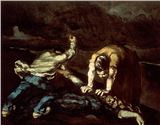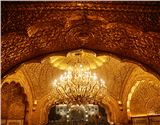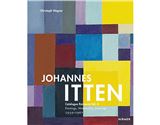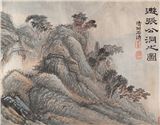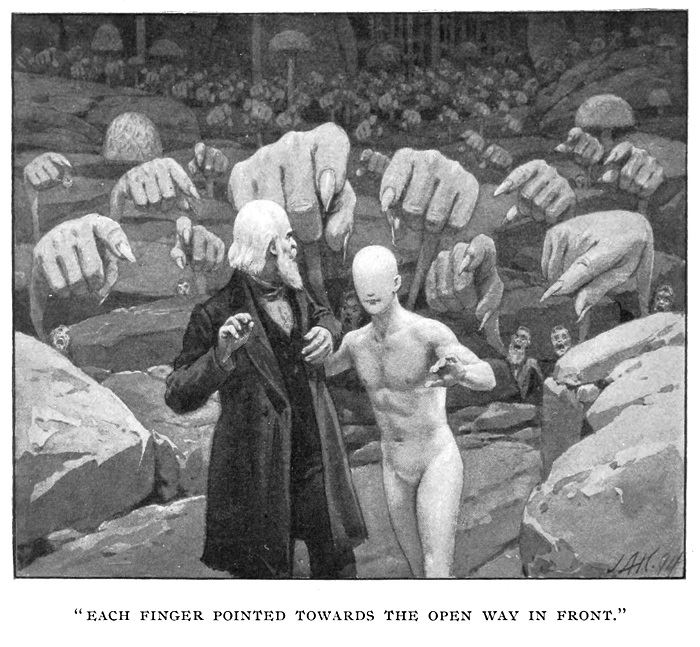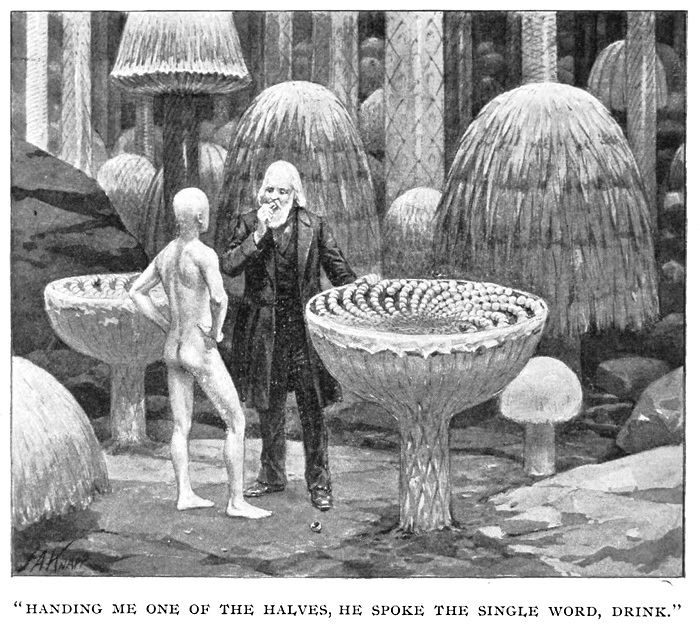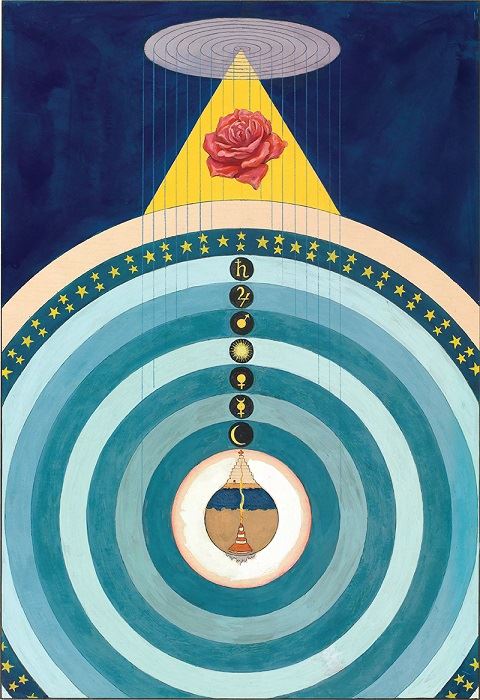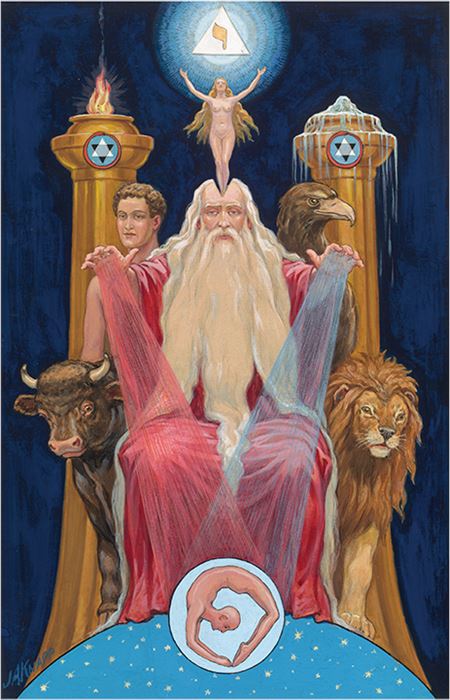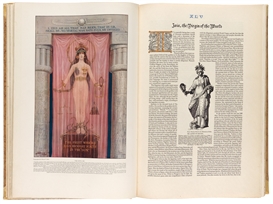Augustus Knapp’s Secret Teachings
One of the first to illustrate the effect of psychedelic alkaloids, Knapp was deeply entrenched in esoteric teachings, providing visual representation of metaphysical concepts
Michael Pearce / MutualArt
Feb 22, 2023
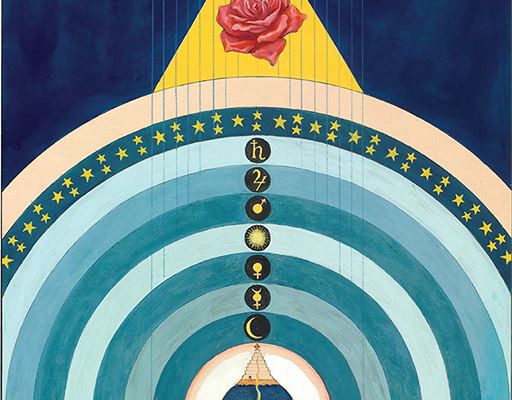
The dreary official chronicles of conventional 20th-century art history have completely ignored the memory of Augustus Knapp, who reached an audience of millions and captured their hungry imaginations through print media. His pictures are bright, mysterious, and enchanting, and have a retro-Victorian charm which is as appealing now as it was before the Second World War. Despite the lack of interest shown by the avant-garde establishment, Knapp was an important and influential trailblazer for the popular psychedelic and visionary art which has become a phenomenon in the 21st century, attended to by legions of collectors and fans.
Knapp is principally known for the illustrations he made for The Secret Teachings of All Ages, the “big book” written and published by the charismatic Manly Hall in 1929, and for a set of tarot cards now known as the Knapp Hall deck. The Secret Teachings is a survey of the symbolical and esoteric philosophy of historical and modern Masonic, Hermetic, Qabbalistic, and Rosicrucian groups, and includes detailed chapters on Atlantis, the gods of antiquity, the Egyptian pyramids, Pythagoras, ceremonial magic, therapeutic medicine, and the fraternal organizations of Hall’s period. It has been printed and re-printed, and millions of copies of the book, both with and without Knapp’s illustrations, have passed through the hands of people interested in the account of metaphysical wisdom. While it is impossible to calculate the influence of the book, it is most certain that Knapp’s pictures made a profound impact on the imaginations of its readers, and doubtlessly impressed and guided artists with an interest in expressing metaphysical imagery.
John Augustus Knapp, Atlantean Temple, Gouache on card
Knapp’s artistic career began when he took a job designing imagery for Strobridge Lithography in Cincinnati, Ohio, in 1883. He was thirty years old. The company produced colorful posters promoting circus and vaudeville acts, theater bills, and commercial products, and the strong conventions of 19th-century advertising had a life-long impact upon Knapp’s aesthetic. His body of work is entirely in gouache (an opaque water-based medium), pencil, and pen and ink – media well suited for the requirements of speedy delivery and the technical processes of printing.
John Augustus Knapp, Etidorhpa, Each Finger Pointed Toward the Open Way in Front
Before his meeting with Manly Hall, Knapp worked for John Uri Lloyd, the remarkable leader of the eclectic medicine movement, who was also an author. Lloyd began his literary career with a remarkable novel called Etidorhpa, published in 1895, a curious mixture of hollow-earth science fiction and 19th-century occultism. In it, the protagonist – identified only as “I-Am-The-Man” – betrays the initiatory rituals of the mysterious secret society he has joined and is kidnapped by his brethren, who transform him by alchemical practices into an old man. He is taken to Kentucky, where he is delivered to the care of an eyeless, nose-less humanoid, with skin the color of light blue putty and the texture of a wet hunting dog, who grasps his arms and pushes him through the water which flows from the mouth of a cave into the entrance to the hollow earth. In the vast chambers of the caverns within, giant mushrooms grow, and light emanates from the walls. His weird guide gives him the meat of the mushrooms to eat, and makes him drink an elixir of their juice. Soon, I-Am-The-Man experiences the psychedelic effects of the mushrooms, flees in terror from beings with huge hands, and learns that he can gently float down huge heights, and leap effortlessly over boulders. Wonderful creatures fly and beautiful reptiles crawl in the caves. He is led to a boat which sails effortlessly across a becalmed and mirrored sea, and reaches the edge of the underground ocean, which is guarded by eponymous Etidorhpa – whose name spells Aphrodite when reversed – and he is allowed to enter her blissful land beyond the underworld.
John Augustus Knapp, Etidorhpa, The Bit of Garment Fluttered Listlessly Away to the Same Distance, and then, Vacancy
Etidorhpa was a popular and critical hit, and went to eighteen editions, bringing Lloyd and Knapp creative fame.
Knapp was one of the first Anglo-American artists to attempt to capture the overwhelming visual effects of psychedelic alkaloids. Although his extraordinary paintings for Etidorhpa were all rendered en grisaille, they somehow evoke the overwhelming color and tumbling imagery of the hallucinatory sensuality of psylocibin. They are ground-breaking precursors to the fantasy and science fiction art of the twentieth century.
John Augustus Knapp, Etidorhpa, Handing me one of the Halves, he Spoke the Single Word, Drink
The visionary energy Knapp found for Etidorhpa slumbered during the first two decades of the 20th century, as he followed a reliable if repetitive career as an illustrator of children’s stories for a Sunday school periodical, but he discovered an imaginative new life in his early seventies when he took a job at Thomas Ince’s movie studios in Culver City. Ince was a prolific and innovative film maker who set the model for the rapid production of the studio system in fledgling Hollywood, and, like Knapp, an enthusiastic theosophist. Knapp was suddenly thrust into the glamorous world of motion pictures, painting some of the great performers of the silent and silver screen, including Milton Sills, John Bowers, and Madge Bellamy, and creating a flood of posters, advertising, and brochures promoting Ince’s movies. But in 1924, Knapp’s movie career was suddenly cut short when Ince died in mysterious circumstances after a cruise on William Randolph Hearst’s yacht, Oneida.
Fortunately, Manly Hall, the charismatic founder of The Philosophical Research Society in Los Angeles, hired Knapp’s second wife, Laura, an eclectic doctor who had trained in Lloyd’s medical program in Cincinnati, to speak about the esoteric anatomy. His meeting with Knapp was fortuitous, and the two began working together on a series of Hall’s books, including the immensely popular Secret Teachings of All Ages, and a collection of paranormal and occult stories, and an explanation of the rites and mysteries of the freemasons. This was comfortable territory for Knapp, who had been a freemason since the turn of the century, and was a prominent theosophist during the 1890s. In Knapp, Hall found a reliable guide to the initiatory rituals of masonry, and a genuine link into the hierarchal world of Madame Blavatsky and the Secret Masters of her mystical organization.
John Augustus Knapp, Dante Divine Comedy, Gouache on card
The imagery of the Secret Teachings is deeply connected to the emblem books and rare alchemical texts Hall collected – his library of ancient volumes was so valuable that his alchemical books are now the pride of the Getty Museum. Knapp understood the use of allegorical symbols – in Hall’s library he would certainly have seen Alciati’s Book of Emblems, which spawned a popular literary genre lasting for three centuries, in which metaphorical images were coupled with epigrams, giving moral instruction – the deeper, and more thoughtful precursors to today’s simplistic memes. The paintings are meant to be understood slowly, to reveal their meanings through study and contemplation of the text and the picture together. They were integral to the big book. When Hall held an exhibit for the benefit of subscribers to the book, he showed treasures from his collection of rare books beside twenty-five of Knapp’s completed paintings, together with plates from the Los Angeles lithographer to demonstrate the faithful quality of the prints.
John Augustus Knapp, Ancient of the Ancients small
Among the images enriching the pages of the Secret Teachings are pictures which surely guided the hands and hearts of future visionary artists. These images of esoteric symbolism were impressive icons which penetrated their imaginations. His iconic Atlantis established the light-soaked pyramids of the mythic and vanished land as the idyllic setting for imaginative fantasies of a utopian past. His colorful diagrammatic illustrations of esoteric concepts are born from the same theosophical world as the abstract works of Hilma af Klint, who created her paintings for the temple between 1906 and 1915, inspired by the same theosophical classic book Thought Forms which doubtlessly inspired Knapp, and Wassily Kandinsky, and Agnes Pelton. Pelton was a founder member of the Desert Transcendentalists in 1929 and owed her theosophical and hermetic imagery to the same streams followed by Knapp, and her circle of colleagues certainly followed Manly Hall’s successful pastoral career as a leader of esoteric thought.
A visionary army of fantasy and science fiction artists followed Knapp’s esoteric lead. His rich imagery provided them with a formidable predecessor in the artistic lineage of American esotericism.
For more on auctions, exhibitions, and current trends, visit our Magazine Page


